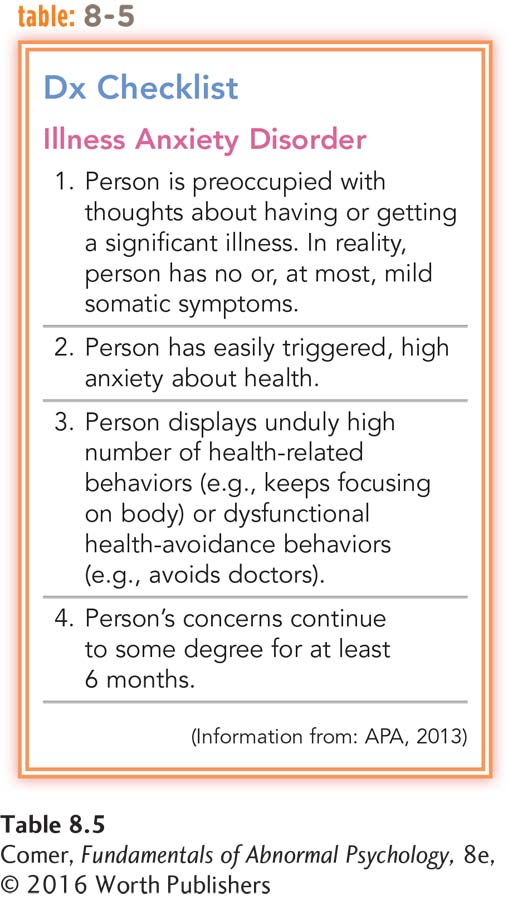8.3 Illness Anxiety Disorder
illness anxiety disorder A disorder in which people are chronically anxious about and preoccupied with the notion that they have or are developing a serious medical illness, despite the absence of somatic symptoms. Previously known as hypochondriasis.

People with illness anxiety disorder, previously known as hypochondriasis, are chronically anxious about their health and are convinced that they have or are developing a serious medical illness, despite the absence of somatic symptoms (see Table 8.5). They repeatedly check their body for signs of illness and misinterpret various bodily events as signs of serious medical problems. Typically the events are merely normal bodily changes, such as occasional coughing, sores, or sweating. Those with illness anxiety disorder persist in such misinterpretations no matter what friends, relatives, and physicians say. Many of these individuals recognize that their concerns are excessive, but many do not.
Although illness anxiety disorder can begin at any age, it starts most often in early adulthood, among men and women in equal numbers. Between 1 and 5 percent of all people experience the disorder (Weck et al., 2015; Abramowitz & Braddock, 2011). Their symptoms tend to rise and fall over the years. Physicians report seeing many cases (Dimsdale et al., 2011). As many as 7 percent of all patients seen by primary care physicians may display the disorder.
Theorists typically explain illness anxiety disorder much as they explain various anxiety disorders (see Chapter 4). Behaviorists, for example, believe that the illness fears are acquired through classical conditioning or modeling (Marshall et al., 2007). Cognitive theorists suggest that people with the disorder are so sensitive to and threatened by bodily cues that they come to misinterpret them (Witthöft & Hiller, 2010).
People with illness anxiety disorder usually receive the kinds of treatments that are used to treat obsessive-
Summing Up
ILLNESS ANXIETY DISORDER People with illness anxiety disorder are chronically anxious about and preoccupied with the notion that they have or are developing a serious medical illness, despite the absence of substantial somatic symptoms. Theorists explain this disorder much as they do anxiety disorders. Treatment includes drug, behavioral, and cognitive approaches originally developed for obsessive-